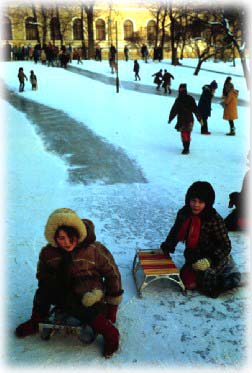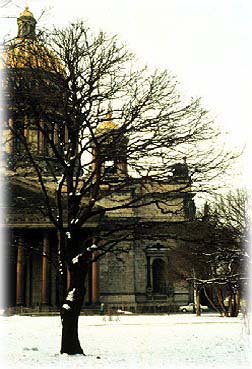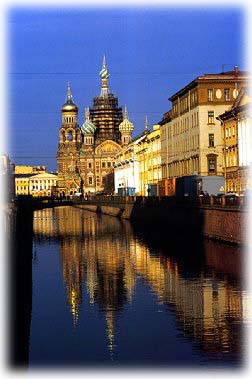In 1703 Peter the Great himself laid a foundation stone in shifting, swampy peat for a city he envisioned as becoming grand, imperial, and above all, Western. St. Petersburg, the apple of Peter's eye that would become the capital of his empire, was forcefully erected on the delta of the Neva river and along the banks of 86 rivulets and canals. There can be no doubt that the chore of shoring up the swampy northern delta was immense; it is said that the city is built upon the bones of the forced labor Peter enlisted. Peter's Paris, his Venice of the North, his Window to the West, his grand capital did become everything he desired, a monument to his greatness.

But another current runs in Piter's (the vernacular for St. Petersburg) canals, too. Though the city still stands, the swamp has never given up. Foggy, misty, messy streets become eerie in the afternoon darkness of winter. Hollow echoes of olden times rebound off the palace walls lining the streets now crowded with beggars and vendors of secondhand merchandise, mushrooms picked in the forest. Dostoyevsky called it "the most abstract and contrived city on the entire earthly sphere," and the city plays a part in his novels, and in the works of Pushkin, Gogol, Belyi, and others, as if it were a living, breathing, uncertain character. One is never sure what one will meet around the next sharp street corner.
Regardless of the season, Piter is a city of surprises.
Along Nevski Prospect (Avenue), the city's celebrated main street, you will find this statue of a man struggling with a stallion. I like how the photo captures the old empire rearing its head proudly, though today's beggar sits among the shadows of passersby in the foreground. The statue is but one in a series of 4 that adorn the corners of Anichkov bridge, each statue depicting another stage in the man's attempt to tame the beast. Man overcoming unruly nature. Peter converting swamp into city. Though the last statue in the sequence indicates man is the victor, it was the swamp that fought back and took Peter's life (he died of pneumonia resulting from a flood that filled his capital in 1725). The Fortress of Peter and Paul is the cornerstone of the city. Originally a bulwark against the Swedes, it was the first structure erected in the city (other than Peter's hut) and remains today one of the most conspicuous.
The Cathedral of Peter and Paul, inside the fortress walls, lifts its golden steeple high above the city so that its guardian angel, atop the spire, might see all. This spire was the first to be raised in Russia, well-known for its orthodox onion domes.

Built on Hare's Island where no auto-traffic is allowed, the fortress offers today's denizens and tourists a refuge from the bustling city streets. While living in Petersburg I loved to take walks along the walls of the fortress on the bank of the Neva and look across the river at the city's magnificent panorama. This photo was taken within the fortress walls on a day so cold (-10F) one could breathe only through the warmth of a scarf, but so beautiful I will never forget it: the silver branches and golden spire reaching for the blue blue sky.
The words of Alexander Pushkin:
"I love thee, masterpiece of Peter...graceful and severe. Neva's
Mighty stream, her granite banks, stiff lace of iron fences...
I love thy cruel winters, the frost and moveless air...
The girls with faces brighter than roses"
Cheerful faces! Smiles! Fun! It was always so pleasant to hear the laughter of a child in those days of panic and grief. But seeing this shot, seeing the little sleds (vehicles, now, of pleasure!) always reminds me of The Siege of Leningrad (during WWII) and how half the city starved to death and the other half dragged the corpses to mass graves on those very sleds. And that reminds me of The 2nd Siege, as one lady put it--the days I experienced.  It was on New Year's Day 1992 that the government did away with the ration coupons we had been using to buy what sugar, butter, and other staples we could find, and let the price of everything begin to rise. Nearly all prices tripled that day. Can you imagine? Thereafter, prices would increase daily, doubling each week. Eggs would disappear from store shelves for a week, then reappear at twice the price. The cost of the simplest little thing became a major topic of discussion as rampant inflation wiped out life savings and whipped all into a panic and depression. I saw rotten apples for sale at exorbitant prices.
It was on New Year's Day 1992 that the government did away with the ration coupons we had been using to buy what sugar, butter, and other staples we could find, and let the price of everything begin to rise. Nearly all prices tripled that day. Can you imagine? Thereafter, prices would increase daily, doubling each week. Eggs would disappear from store shelves for a week, then reappear at twice the price. The cost of the simplest little thing became a major topic of discussion as rampant inflation wiped out life savings and whipped all into a panic and depression. I saw rotten apples for sale at exorbitant prices.
The elderly marched out of retirement and stood long hours on street corners selling newspapers, cabbage pies, worn out clothing, and flowers. FLOWERS! In the middle of a bleak winter, flowers were available and beautiful. One didn't need to buy them; a look lifted one's heart. Color in an otherwise colorless world (these were the days before Western advertising splashed a rainbow of neon and billboards across the city; I remember the day I descended down into the subway and found myself face-to-face with the Marlboro Man--my God was he out of place, I thought).
During those hard times (and I don't mean to imply they've entirely passed) I enjoyed so much the solid, tranquil, ornamented cathedrals. To slip through a door as heavy as the ages and find oneself among echoing whispers, the heavenly glow of candles burning under darkening icons, the cool grotto-like feel of a tomb, all worked like a sedative upon frayed nerves.

A structure as colossal as St. Isaac's Cathedral imparts yet another level of grandeur; the exotic riches of the Russian Orthodox church are showcased here in this cathedral preserved by the communists as a museum (now serving as a church again!). From the outside the streets and ant-like cars on them are dwarfed by columns that stand unmoving, a mountain of granite in a sea of swirling change.
Such pre-revolutionary architecture makes downtown St. Petersburg a living museum, a pearl in the oyster of today's city. Beyond the center, one finds the so-called "sleeping districts," the "neighborhoods" where the populace lives (or at least sleeps; living seems to be too relative a term).
More housing has been thrown up overnight in the last 50 years than in all of the preceding 250. The reality of that statistic is mind boggling. A Soviet tour book reads: "The city has extended its boundaries. Excellent residential districts with much greenery have grown up." Excellent if you like horrific concrete squares surrounding you like prison bars. Excellent if you are color-blind, have no sense of aesthetics, don't know what a front yard is, much less a picket fence, or privacy. Excellent if you've already waited 10 years for an apartment so you, your wife, and child no longer have to sleep in your in-law's kitchen.
The name "sleeping districts" seems apt insofar as I always felt my brain go numb among the stark high-rise apartments--cut outs from some horrific science fiction novel (so they seemed to this country boy). They loomed in my nightmares. And yet they swarmed with life as common and warm as in any Kansas farmhouse. This paradox prompted me to write the following poem:
Saint Petersburg
Oxymoron lovers tell me she is a beautiful city.
Unnatural eyesore, her cinder block breasts rise like cancer from the swamp:
Malignant Eggsacks of Armageddon
Gutted Lunar Landscape
Schiaparelli's Martian Canals
Garden of Ruined Stone.
Nearer, one realizes countless millions inhabit them.
People, in fact,
smoking pipes
reading newspapers
nursing their young
I felt very privileged to be writing what I pleased. Others have not enjoyed that luxury. Jewish writer Isaac Babel once quipped: "...but wasn't it a mistake on God's part to settle Jews in Russia where they live like in hell? Why couldn't He have settled Jews in Switzerland where they'd be surrounded by first-class lakes, where they'd breathe mountain air and be surrounded by nothing but the French?" This he wrote during Stalin's reign, and one day mysteriously disappeared, never to be heard from again.

Doesn't it seem that times in Russia have always been most tumultuous? Czar Alexander II was hailed by many as a progressive ruler leading the country out of the woods, then got blown up by a terrorist's bomb in 1881. As typical in Russia, something beautiful arose on the spot of disaster: Saviour on the Spilt Blood Cathedral.
Often confused with St. Basil's in Moscow, this cake has all the icing. Built on the spot were Alexander II was assassinated, alongside Canal Griboyedeva, Saviour on the Spilt Blood delights tourists walking along Nevski. And why shouldn't it? Its colorful domes burn with the passion of the Russian soul. Not much needs to be said. As the Russian say, "one seeing is worth 1000 tellings.
Walton Conway